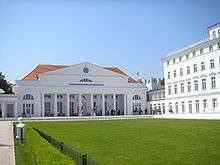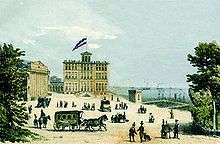Carl Theodor Severin
Carl Theodor Severin (13 September 1763, Mengeringhausen – 20 February 1836, Bad Doberan, Germany) was a German architect. He is regarded as one of the most important representatives of classicism in Mecklenburg.

Life
Severin was born the first child of the government and consistory council Theodor Severin (born 1733) and his wife Christina Eleonore Henrietta Becker (born 1744). Nothing is known about his education as an architect. From 1789 onward, he was based in Mecklenburg.
In 1795, he was hired as the bauconducteur to the construction manager of Doberan, who was at that time Johann Christoph Heinrich von Seydewitz. Severin was to assist him until his retirement in 1796. Since Seydewitz stayed in the office for a longer period than expected, Severin first became a chamber engineer in 1795 without a salary at the Schweriner Kammerkollegium, and in November 1795 he was given the position of "bauconducteur to the local court and town buildings". In 1799, he rebuilt the Gut Nustrow, which had been owned by the von Schack family for only a few years.[1] In 1801, Severin planned out for the first time during the construction work for the summer residency of the ducal [from 1815: Großherzoglichen] Sommeritzitz at Heiligendamm. Together with Seydewitz, the salon building at the Kamp was built. Through this work, Friedrich Franz I drew attention to him and entrusted Severin with extensive work to expand the seaside resort of Heiligendamm and to redesign the village of Doberan.
In 1803, Severin built a sanctuary in Heiligendamm and a cultivation of the bathhouse, the conversation round in 1804 and the view tower in 1807. Nearly all of these buildings are no longer preserved.
His first buildings in Doberan included the theater, which he built in 1805. From 1806 to 1809, his repertoire was followed the ducal palace and 1808 a pavilion at the Kamp. In April 1809, Severin was appointed as land architect. He was thus responsible for the offices of Buckow, Doberan, Ribnitz, Rühn, Toitenwinkel and Schwaan. The focus of his work continued to be the expansion of Heiligendamm and Doberan, which is why he moved to Doberan in 1810 and built a house. In the same year he married Marie Eleanore Magdalena Bollow (born 1783). The couple had three daughters and two sons.

Albeit with some difficulties, from 1810 to 1813 at the Kamp, several pavilions were built there, particularly the Große Pavillon as a music pavilion.
In 1814, Severin was commissioned to build a representative building as a social, dance and dining house in Heiligendamm. Today, this building, completed in 1817, is the Kurhaus Heilingendamm and currently a part of a hotel complex.
Carl Theodor Severin was appointed Oberland builder in March 1819.
His last works in Doberan included cultivation at the salon building at Kamp from 1819 to 1821 and the steel bath, which was completed in 1825. The house of Severin, which was situated south of the Kamp, was exchanged for the Duke of Mecklenburg-Schwerin, Friedrich Franz Is wish to erect a palace for the heir prince, against a piece of land directly opposite the same road, and erected a palatial, representative building there in 1823-1824. This house is now called Gottesfrieden.
A major element of Severin's design and architecture was the exotic motifs of Chinese architecture. It is thanks to him that Bad Doberan today is one of the few places in Germany today with a uniform neoclassicism style to its architecture.
In 1822, he built the new building of the mansion in Körchow. He also built the house of Italian-born restaurateur Gaetano Medini.
In 1835, he retired, and in 1836, died in Doberan.
Important projects and buildings
In Bad Doberan

- Kleiner Pavillon auf dem Kamp, 1808–1809
- (Groß-) Herzogliches Palais, 1806–1809
- (Groß-) Herzogliches Salongebäude, 1801–1802
- Großer Pavillon, 1810–1813
- Kleines Palais, 1810–1813
- Prinzenpalais 1821–1822
- Haus Gottesfrieden 1823–1824
- Stahlbad 1825
In Heiligendamm
- Gesellschafts-, Tanz- und Speisehaus (heute Kurhalle) in Heiligendamm, 1814–1816
In Rostock
- Neue Wache, 1823
References
- Herrenhäuser in Westmecklenburg: Rittergut Nustrow bei kulturrreise-ideen.de.
Further reading
- Judith Groschang: Bäderarchitektur in Doberan-Heiligendamm. Die Bauten Carl Theodor Severins. 1999, ISBN 3-9806808-1-9.
- Hans Thielcke: Die Bauten des Seebades Doberan - Heiligendamm um 1800 und Ihr Baumeister Severin. Godewind Verlag, 2004, ISBN 3-938347-90-2. (Reprint der Originalausgabe von 1917)
External links
- Literature about Carl Theodor Severin in the State Bibliography (Landesbibliographie) of Mecklenburg-Vorpommern